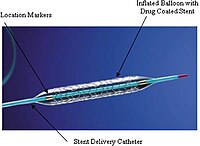
Photo from wikipedia
Objectives Despite the increasing use of endovascular techniques in the management of peripheral vascular disease, there is little data on the safety of percutaneous closure devices in punctures of synthetic… Click to show full abstract
Objectives Despite the increasing use of endovascular techniques in the management of peripheral vascular disease, there is little data on the safety of percutaneous closure devices in punctures of synthetic vascular material. Our paper sought to address this paucity in the literature by reviewing the incidence of complications occurring in patients in whom the ProGlide device was utilised to achieve haemostasis post-percutaneous puncture of vascular patches and graft materials. Methods A retrospective review of patient records was conducted at a tertiary referral centre. Patients who had undergone percutaneous punctures of prosthetic bypass grafts or patch angioplasties between January 2011 and December 2020 were identified from a prospectively collected database. Medical records and post-procedural imaging were reviewed to assess the occurrence of post-procedural complications such as pseudoaneurysms, puncture site stenosis and further interventions for access complications. Results A total of 73 punctures of prosthetic material were performed in 42 patients, of which 39 utilised ProGlides. Median age of included patients was 72 years. There was male predominance in the cohort (69.8%), and most punctures (87.3%) were through polyurethane patches. Device success rate was 95%, and no patients required open repair. There was a low incidence of complications, with no patients developing pseudoaneurysms, arteriovenous fistulas, ischaemic limbs or > 50% stenosis when either manual pressure or the ProGlide device was used to achieve haemostasis. Furthermore, there were no returns to theatre or further interventions performed for access site complications. Conclusion The use of the ProGlide closure device has a low incidence of complications and its safety appears to be equivalent to manual compression when used to achieve haemostasis in percutaneous punctures of synthetic vascular material in select patients. To our knowledge, this is the only article to date to assess the safety of the ProGlide in this setting.
Journal Title: Vascular and Endovascular Surgery
Year Published: 2022
Link to full text (if available)
Share on Social Media: Sign Up to like & get
recommendations!